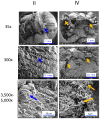Intestinal tissues induce an SNP mutation in Pseudomonas aeruginosa that enhances its virulence: possible role in anastomotic leak
- PMID: 22952955
- PMCID: PMC3432121
- DOI: 10.1371/journal.pone.0044326
Intestinal tissues induce an SNP mutation in Pseudomonas aeruginosa that enhances its virulence: possible role in anastomotic leak
Abstract
The most feared complication following intestinal resection is anastomotic leakage. In high risk areas (esophagus/rectum) where neoadjuvant chemoradiation is used, the incidence of anastomotic leaks remains unacceptably high (≈ 10%) even when performed by specialist surgeons in high volume centers. The aims of this study were to test the hypothesis that anastomotic leakage develops when pathogens colonizing anastomotic sites become in vivo transformed to express a tissue destroying phenotype. We developed a novel model of anastomotic leak in which rats were exposed to pre-operative radiation as in cancer surgery, underwent distal colon resection and then were intestinally inoculated with Pseudomonas aeruginosa, a common colonizer of the radiated intestine. Results demonstrated that intestinal tissues exposed to preoperative radiation developed a significant incidence of anastomotic leak (>60%; p<0.01) when colonized by P. aeruginosa compared to radiated tissues alone (0%). Phenotype analysis comparing the original inoculating strain (MPAO1- termed P1) and the strain retrieved from leaking anastomotic tissues (termed P2) demonstrated that P2 was altered in pyocyanin production and displayed enhanced collagenase activity, high swarming motility, and a destructive phenotype against cultured intestinal epithelial cells (i.e. apoptosis, barrier function, cytolysis). Comparative genotype analysis between P1 and P2 revealed a single nucleotide polymorphism (SNP) mutation in the mexT gene that led to a stop codon resulting in a non-functional truncated protein. Replacement of the mutated mexT gene in P2 with mexT from the original parental strain P1 led to reversion of P2 to the P1 phenotype. No spontaneous transformation was detected during 20 passages in TSB media. Use of a novel virulence suppressing compound PEG/Pi prevented P. aeruginosa transformation to the tissue destructive phenotype and prevented anastomotic leak in rats. This work demonstrates that in vivo transformation of microbial pathogens to a tissue destroying phenotype may have important implications in the pathogenesis of anastomotic leak.
Conflict of interest statement
Figures







Similar articles
-
Oral Polyphosphate Suppresses Bacterial Collagenase Production and Prevents Anastomotic Leak Due to Serratia marcescens and Pseudomonas aeruginosa.Ann Surg. 2018 Jun;267(6):1112-1118. doi: 10.1097/SLA.0000000000002167. Ann Surg. 2018. PMID: 28166091 Free PMC article.
-
Novel de novo synthesized phosphate carrier compound ABA-PEG20k-Pi20 suppresses collagenase production in Enterococcus faecalis and prevents colonic anastomotic leak in an experimental model.Br J Surg. 2018 Sep;105(10):1368-1376. doi: 10.1002/bjs.10859. Epub 2018 Apr 16. Br J Surg. 2018. PMID: 29658991 Free PMC article.
-
Emergence of the P2 phenotype in Pseudomonas aeruginosa PAO1 strains involves various mutations in mexT or mexF.J Bacteriol. 2014 Jan;196(2):504-13. doi: 10.1128/JB.01050-13. Epub 2013 Nov 15. J Bacteriol. 2014. PMID: 24244000 Free PMC article.
-
A Pathologic Microbiome Impacts Post-Operative Anastomotic Healing.Surg Infect (Larchmt). 2023 Apr;24(3):238-244. doi: 10.1089/sur.2023.003. Surg Infect (Larchmt). 2023. PMID: 37010973 Review.
-
Postoperative non-steroidal anti-inflammatory drugs and colorectal anastomotic leakage. NSAIDs and anastomotic leakage.Dan Med J. 2012 Mar;59(3):B4420. Dan Med J. 2012. PMID: 22381097 Review.
Cited by
-
Gut Microbiota and Colorectal Surgery: Impact on Postoperative Complications.Clin Colon Rectal Surg. 2016 Sep;29(3):253-7. doi: 10.1055/s-0036-1584502. Clin Colon Rectal Surg. 2016. PMID: 27582651 Free PMC article. Review.
-
Correlation between invasive microbiota in margin-surrounding mucosa and anastomotic healing in patients with colorectal cancer.World J Gastrointest Oncol. 2019 Sep 15;11(9):717-728. doi: 10.4251/wjgo.v11.i9.717. World J Gastrointest Oncol. 2019. PMID: 31558976 Free PMC article.
-
Alterations of gut microbiome following gastrointestinal surgical procedures and their potential complications.Front Cell Infect Microbiol. 2023 Jun 2;13:1191126. doi: 10.3389/fcimb.2023.1191126. eCollection 2023. Front Cell Infect Microbiol. 2023. PMID: 37333847 Free PMC article. Review.
-
Selective Decontamination with Oral Antibiotics in Colorectal Surgery: 90-day Reintervention Rates and Long-term Oncological Follow-up.J Gastrointest Surg. 2023 Aug;27(8):1685-1693. doi: 10.1007/s11605-023-05746-1. Epub 2023 Jul 5. J Gastrointest Surg. 2023. PMID: 37407901
-
Clinical-Pathological Conference Series from the Medical University of Graz : Case No 166: An 82-year-old woman with voluminous diarrhea and weight loss.Wien Klin Wochenschr. 2023 Aug;135(15-16):429-435. doi: 10.1007/s00508-022-02112-0. Epub 2022 Dec 19. Wien Klin Wochenschr. 2023. PMID: 36534207 Free PMC article. No abstract available.
References
-
- Roos D, Dijksman LM, Oudemans-van Straaten HM, de Wit LT, Gouma DJ, et al. (2011) Randomized clinical trial of perioperative selective decontamination of the digestive tract versus placebo in elective gastrointestinal surgery. Br J Surg 98: 1365–1372. - PubMed
-
- Merkel S, Wang WY, Schmidt O, Dworak O, Wittekind C, et al. (2001) Locoregional recurrence in patients with anastomotic leakage after anterior resection for rectal carcinoma. Colorectal Dis 3: 154–160. - PubMed
-
- Lin JK, Yueh TC, Chang SC, Lin CC, Lan YT, et al. (2011) The influence of fecal diversion and anastomotic leakage on survival after resection of rectal cancer. J Gastrointest Surg 15: 2251–2261. - PubMed
Publication types
MeSH terms
Substances
Grants and funding
LinkOut - more resources
Full Text Sources
Medical
Molecular Biology Databases
Research Materials
Miscellaneous

